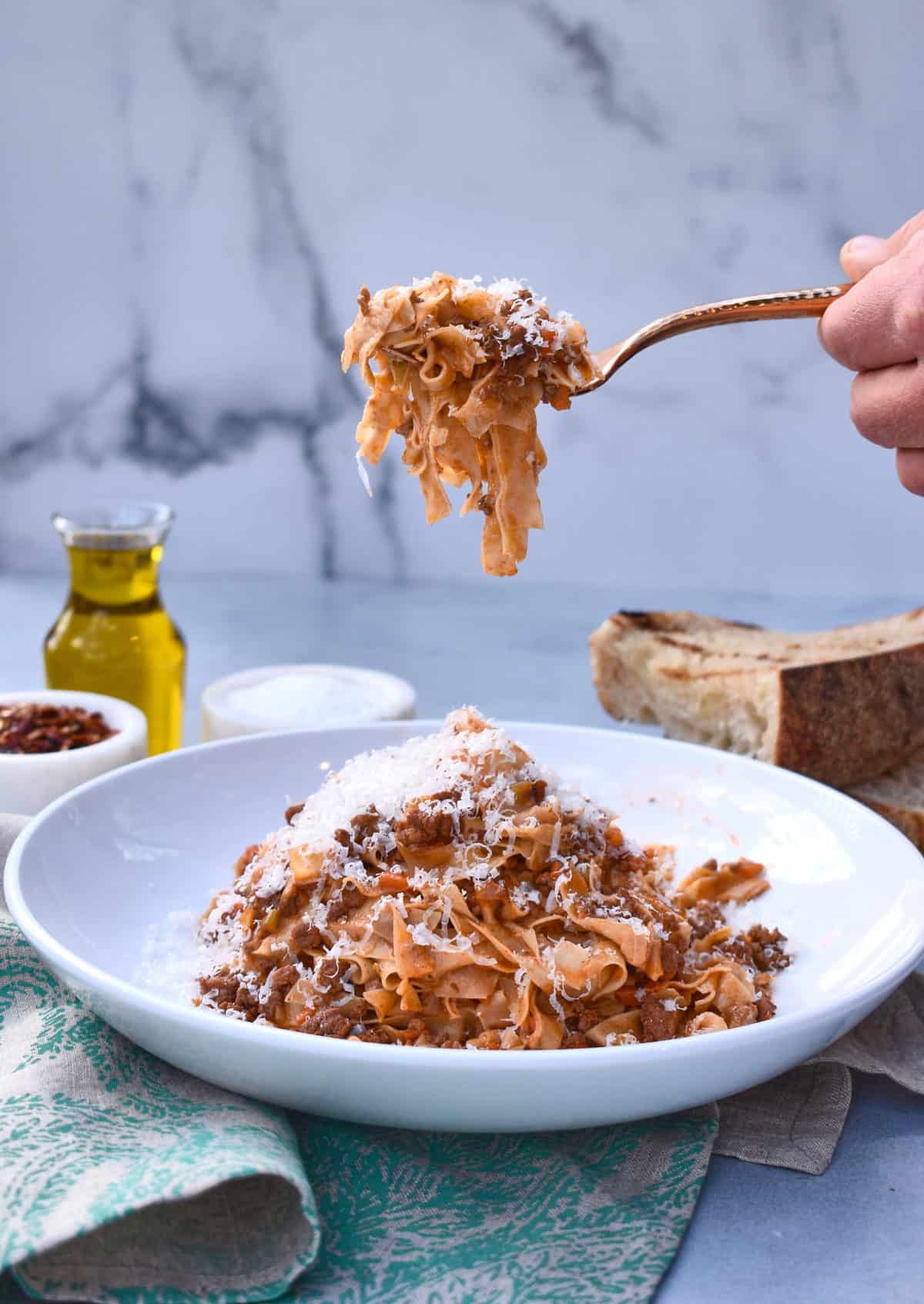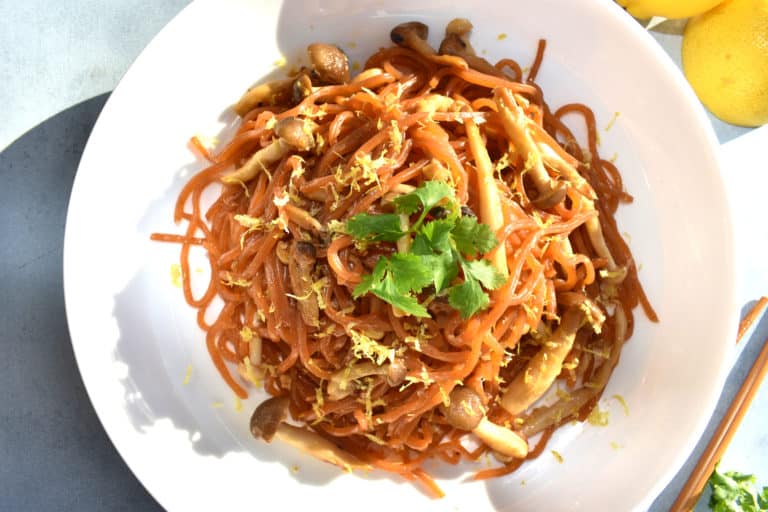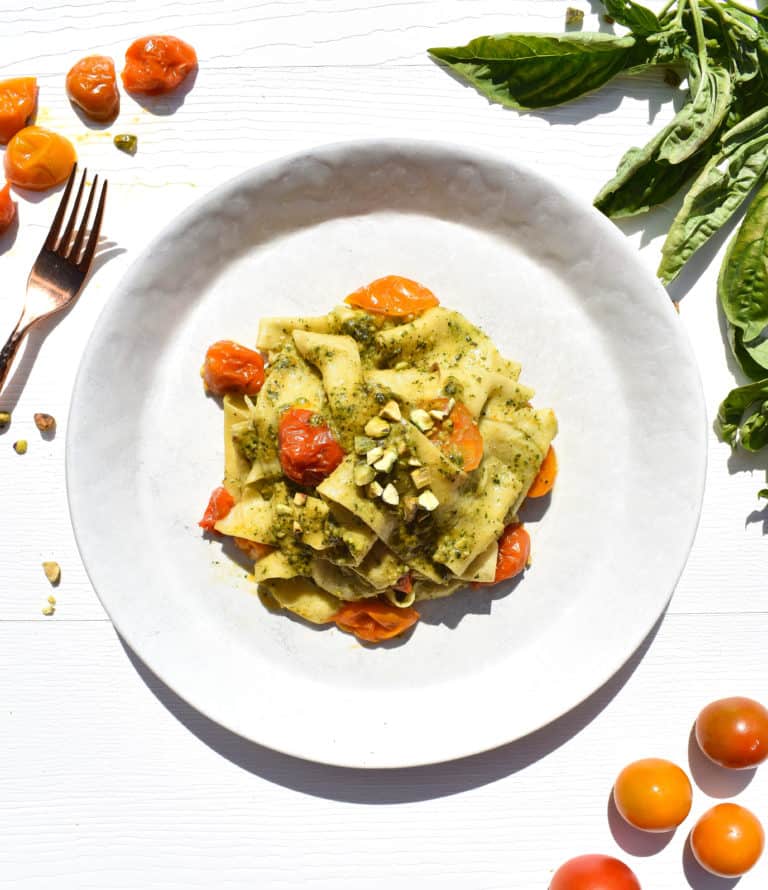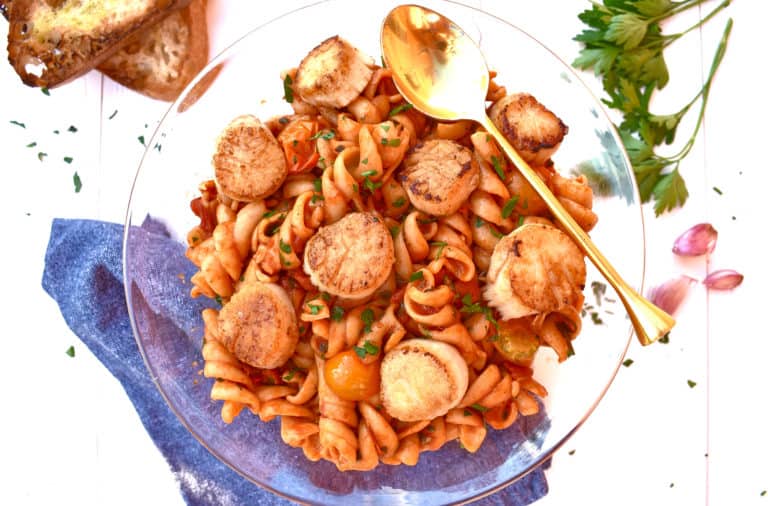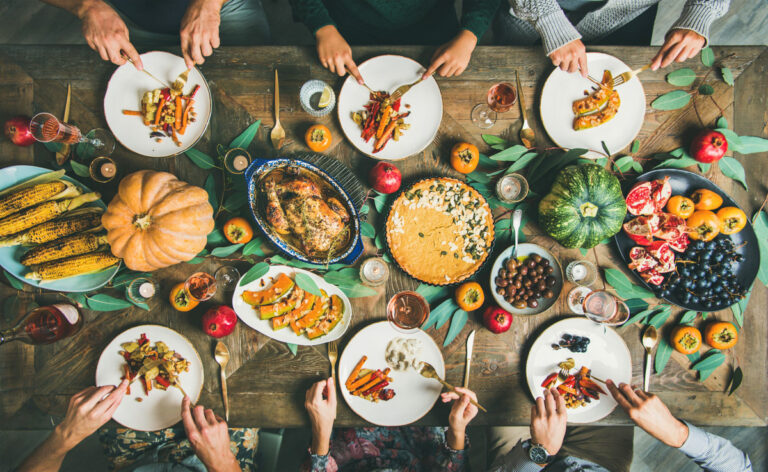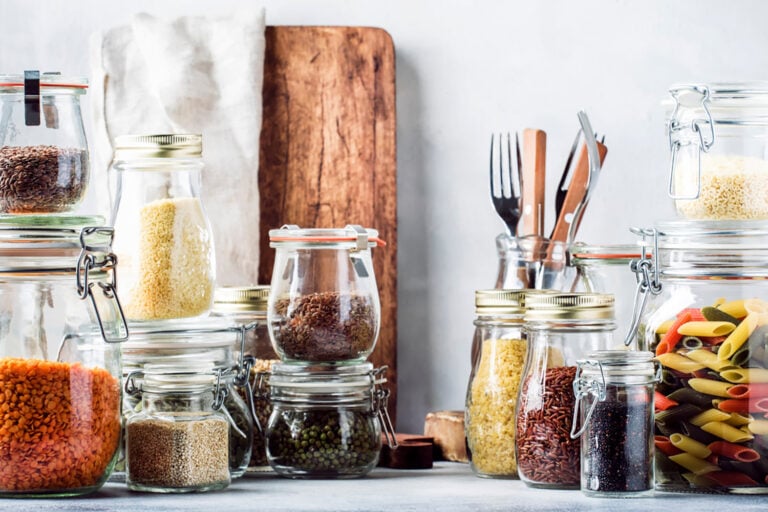The Pasta Bolognese Ingredients Are Below
Garlic: The garlic in the recipe adds a wonderful subtle heat to the sauce. It is not overpowering and melds with the other flavors.
Carrot, Celery, and Onion: This is a classic vegetable combination that is the base and flavoring agent for many traditional ragù and sauces. In French terminology, this combination is called the mirepoix. The word was coined in France back in the eighteenth century when a French aristocrat’s chef first used it. These vegetables are sautéed in butter and oil until tender, and then other ingredients are added to fuse with these flavors.
Ground Beef and Pork: Probably, the most classic meat combination for this Italian ragù is ground beef, ground pork, and ground veal. I omitted the veal from the recipe for ease, but it can be added in as well. The combination of both beef and pork adds a rich and powerful meat flavor to the sauce.
Tomato Paste: This is a crucial ingredient to the sauce. Often you will find Bolognese recipes with a hefty addition of tomato sauce or crushed tomatoes. This recipe highlights the vegetables and meat and uses tomato paste’s sweet thickness to bring these elements together. The tomato flavor is not overpowering or pronounced. It is simply there to enhance the other ingredients. The result is a thick and flavorful ragù, instead of a liquid sauce. The tomato paste is added to the vegetables and meat, and the combination cooks together over moderate heat until the tomato paste starts to caramelize. After this step, the beautiful browned flavorful bits are lifted from the pot as the sauce is deglazed with wine.
White Wine: White wine is used to deglaze the sauce and bring another flavorful element that fuses with the vegetables and meat. White wine is used as it is more subtle and softer than red wine. This recipe places a large focus on the key ingredients of the vegetables and meat, and the other ingredients are there to enhance their flavor. I tend to use a rounded Chardonnay when cooking with white wine. I don’t like to use anything that is overwhelmingly sweet.
Whole Milk: This is the “secret” ingredient of this recipe. The whole milk is added after the vegetables, meat, tomato paste, and wine have melded together to create a reduced sauce. The milk adds a richness to the ragù but does not overpower it with heavy creaminess. It adds the perfect balance.
Olive Oil: Using a high-quality Extra Virgin Olive oil is also key to a superb pasta dish. I love the Italian brand, Lucini. For this recipe, I used the Premium Select Extra Virgin Olive Oil.
Parmigiano Reggiano: Using Parmigiano-Reggiano will change your life! Italians have been eating and making Parmigiano Reggiano cheese for the past eight centuries. Its name comes from the Italian Provence of Parma and surrounding provinces of Reggio, where the cheese originated. An association was formed in this region, stating that for the cheese to be labeled “Parmigiano Reggiano,” it must be produced and made in this region only. In 2008, this became official law in Italy. Look at the label when buying your cheese to make sure that it comes from Italy. Other Parmesan imposters will not have the same nutty and crystalized taste and texture.
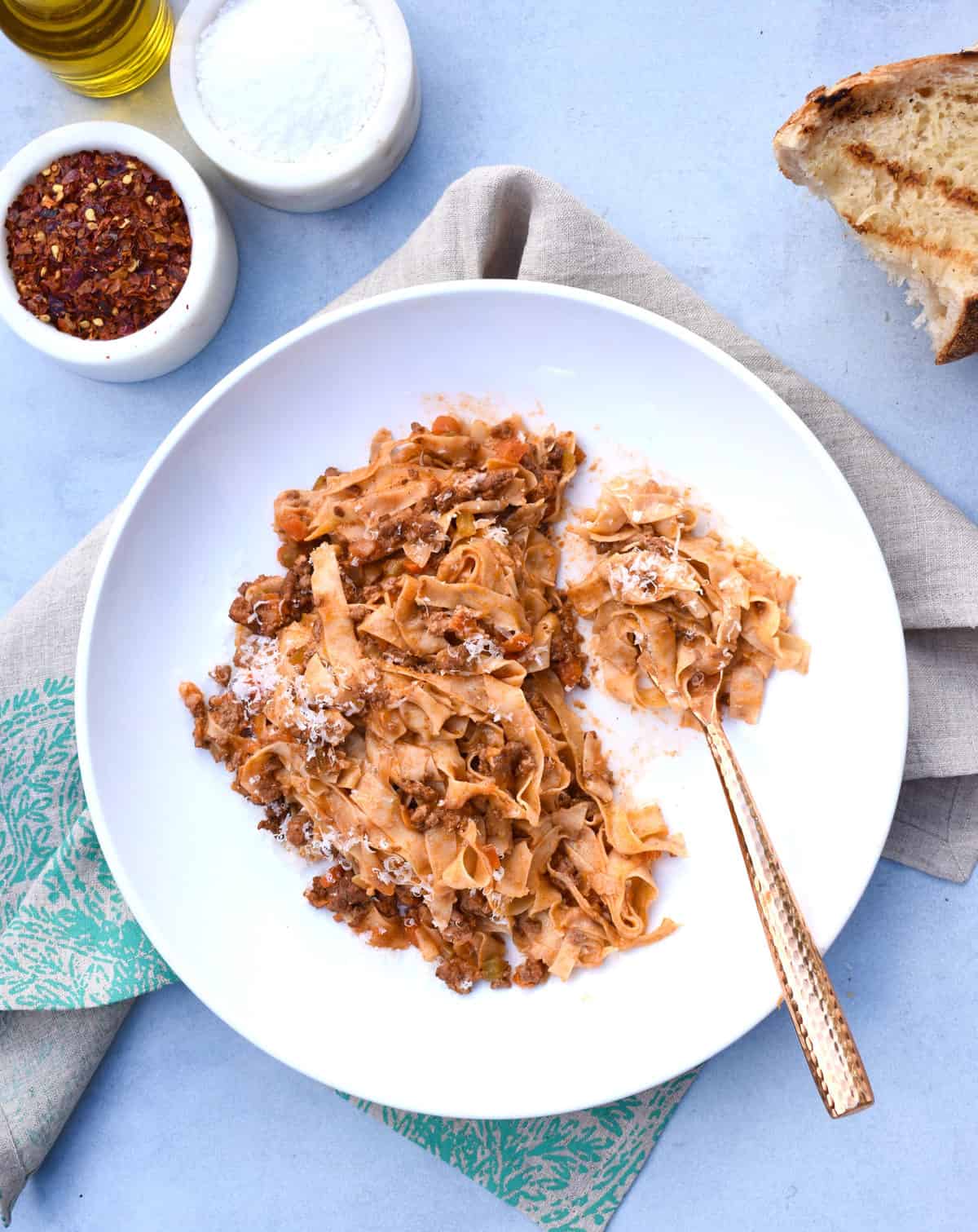
Making the Pasta Dough
- I love making pasta dough by hand. This way, I can feel and work the ingredients by touch and always end up with the best-desired product.
- Place the flour on a work surface in a heaping mound, take your hand, push down in the center, and push the flour away in all directions, creating a 2-inch well.
- Place one egg yolk at a time in the center of the well and use a fork to slowly pull the flour from the sides into the well and mix to incorporate.
- Continue this process until the center well gets bigger and bigger, and more flour is pulled in.
- Add the olive oil and salt into the well and continue whisk with the fork until all the flour has been incorporated.
- Flour your hands and knead the dough about 2-3 minutes until it is soft to the touch and smooth.
- At this point, you should be able to touch the ball of dough with your finger, and it should leave a dent, but have a springiness to the dough.
- Wrap the dough tightly in plastic wrap and leave at room temperature for a minimum of 30 minutes up to 3 hours.
- The resting process allows the gluten to subside and make the dough more malleable and manageable when you are ready to roll it out.
- This dough is wonderful to roll out by hand if you do not own a pasta machine. All you need is a rolling pin and extra flour to coat your work surface!
- The olive oil in the dough and the high yolk content make it easier to roll by hand.
Rolling the Dough by Hand:
- Cut the dough into 4-6 equal pieces.
- Take one piece and place it on a floured work surface.
- Wrap the other remaining pieces in plastic wrap to lock in moisture.
- Start by flattening the dough with your fingers into a 3-inch square.
- Flour a rolling pin and start rolling out the square.
- After each pass of the rolling pin, flip the dough over. This will make for a better and thinner dough if you are constantly flipping and redistributing the contact of the dough with the rolling pin and work surface
- You know your dough sheet is thin enough when holding it up to the light; you can see your hand through the dough.
- Once you have achieved this thickness, dust more flour over the sheet and then roll the sheet over itself into one long ribbon.
- Cut the ribbon into 1-centimeter pieces. Unroll your ribbon and lay flat on a floured baking sheet.
- Repeat until all the dough has been rolled out and cut the same size.
- Note: If you want to place all the cut pasta on one baking sheet, fill up the first layer, place a floured piece of parchment of kitchen towel over the top and continue to line your strips onto this second layer. Repeat until all the pasta is cut.
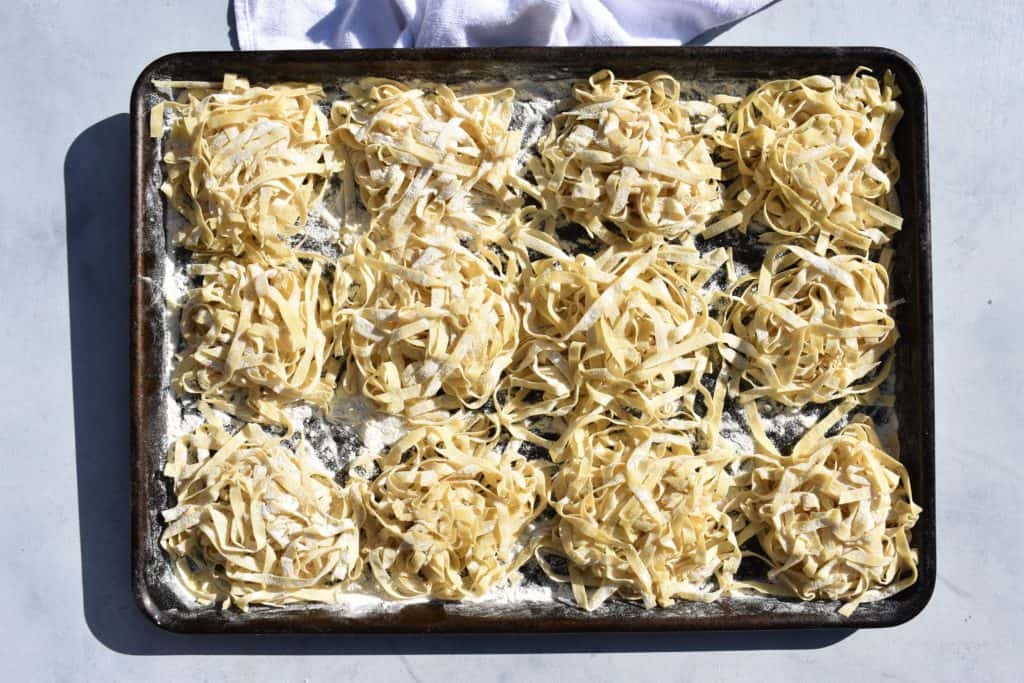
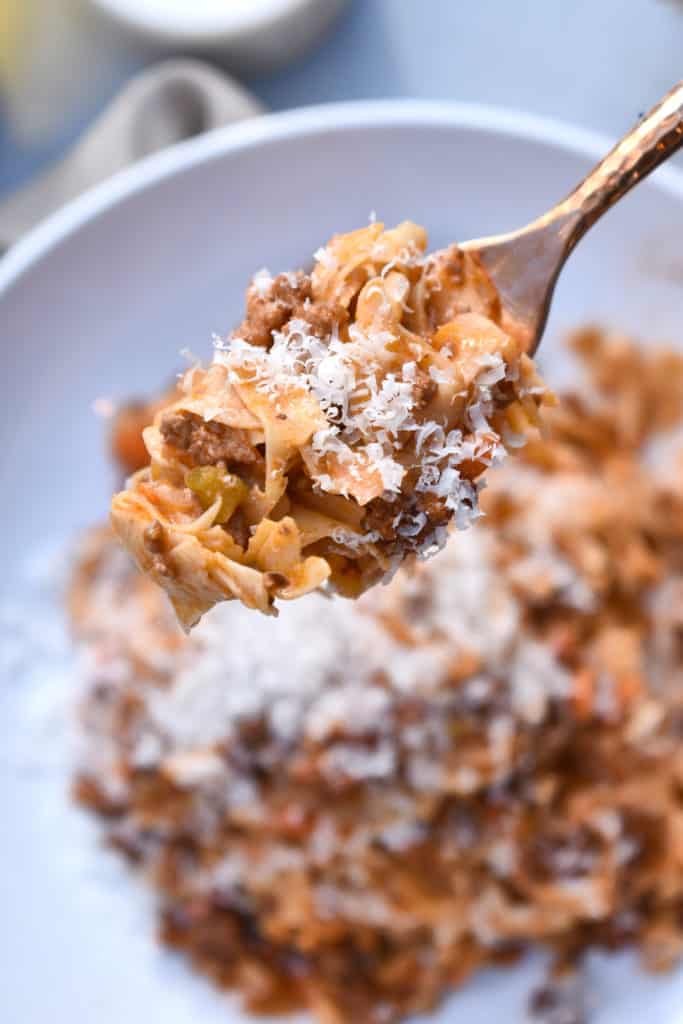
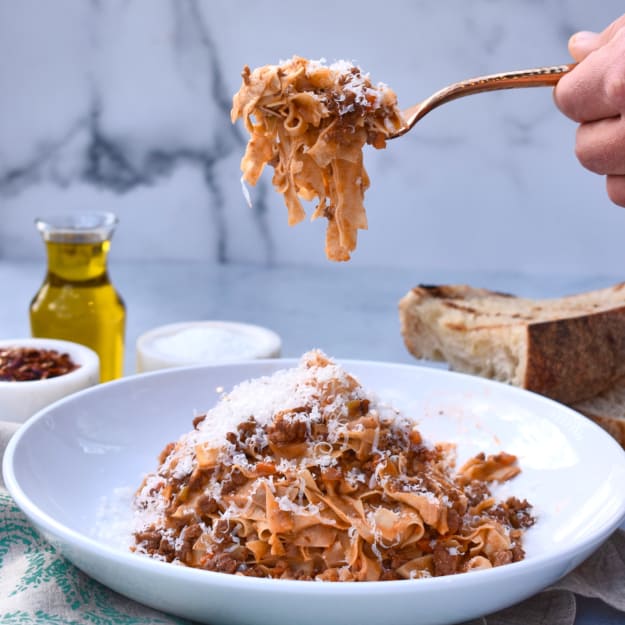
Pasta Bolognese
Ingredients
Pasta Dough
- 2 cups all-purpose flour
- 2 eggs plus 5 egg yolks
- 2 tbsp olive oil
- 1 tbsp kosher salt
- Extra flour for rolling out the dough
Bolognese
- 1 tsp garlic, minced
- 2 carrots, finely diced
- 2 stalks celery, finely diced
- 1 yellow onion, finely diced
- 1 lb ground beef
- 1 lb ground pork
- 4 tbsp tomato paste
- ½ cup white wine
- 1 cup whole milk
- Olive oil to coat the pan
Pasta Cooking and Final Assembly
- 1 recipe cut pasta
- 1 recipe Bolognese
- 6 tbsp unsalted butter
- Parmigiano Reggiano, grated for garnish
Instructions
Pasta Dough
- Place the flour on a clean work surface and make a well in the center.
- One by one, crack the eggs into the well and slowly mix them into the flour wall's sides. Be very careful not to break the well, so the eggs do not leak over the table.
- Add the olive oil and salt into the well and continue to mix until all the flour is combined, and a dough is formed.
- Knead the dough for 8-10 minutes until it is tough and smooth on the outside.
- Wrap the dough tightly in plastic wrap and rest for 30 minutes or up to 3 hours at room temperature.
- Cut the dough into four equal pieces. Take one piece and shape it with your finger into a flattened small square. Keep the other pieces moist by wrapping them in plastic wrap while you work.
- Coat your work surface with flour and roll out the dough with a rolling pin or through a pasta machine. Work to flatten and thin out the dough until it is thin enough to see the light coming through when held up by your hand.
- Take the pasta sheet that is dusted with flour and roll it into a long ribbon. Cut the ribbon into 2-inch pieces and then unroll each piece and reserve on flour coated baking sheet.
- Repeat this process but lining up the ribbons on your baking sheet. When you have filled up the entire baking sheet, place a flour-coated piece of parchment on top, and continue lining up your ribbons until all of the pasta dough is rolled out and cut.
- Place a kitchen towel over the baking sheet to lock in the moisture while making the pesto and heating your pasta water.
Bolognese
- Heat a large saucepan over moderate heat and coat with olive oil.
- Add the garlic, carrot, celery, and onion and sauté until the onion is translucent and the other vegetables are tender (about 4-6 minutes).
- Add the ground beef and pork. Cook until the meat is browned (about 3-5 minutes).
- Add the tomato paste, and let it caramelize for 2-3 minutes.
- Add the wine and reduce until little to no liquid is left.
- Add the milk and continue to reduce for 4-5 minutes.
- Allow the flavors to meld and let this simmer for 12-15 minutes. Season to taste with salt and pepper.
Pasta Cooking and Final Assembly
- Bring a large pot of water to a boil.
- Salt the water to it tastes "salty like the sea."
- Cook pasta in batches. Place 1/3 of the cut pasta into the boiling water.
- Cook the pasta until al'dente, about 3-4 minutes.
- Transfer the cooked pasta directly from the boiling water to the Bolognese. Flip the cooked pasta in the sauce with two tablespoons of butter.
- Repeat this exact process with the remaining two batches of pasta.
- Serve immediately with adjusting of Parmigiano Reggiano.
